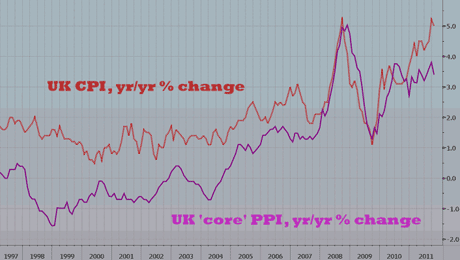• This article was updated on 15 November 2011.
UK inflation indicator: the ‘core’ Producer Prices Index (PPI)
Our cost of living is climbing fast. CPI (the consumer price index) is rising at 5% a year. That compares with the official 2% target.
But the Bank of England reckons that Britain’s cost of living “is likely to fall back sharply next year as the influence of the factors temporarily raising inflation diminishes”.
In other words, it thinks fast-rising costs like food and fuel should stop pushing overall prices up so much. That’s part of its justification for printing more money.
So we should only really worry about ‘core’ inflation, which strips out these nasty volatile bits. And core inflation isn’t a problem… or is it?
Here’s a rather concerning chart. It shows UK inflation – the annual change in CPI – in red. But look at the purple line.

Source: Bloomberg
It’s the annual increase in the ‘core’ Producer Price Index (PPI). This measures so-called ‘factory gate’ prices, ie what Britain’s manufacturers are charging customers for their goods. But it strips out those volatile food and fuel items.
The bad news for UK inflation is that core PPI is accelerating faster than CPI. Over the last decade, the annual change in CPI has risen from 1.2% to 5.0%. But during that time core PPI has climbed from -0.72% to 3.4% a year. And this trend shows no sign of stopping.
As these upward PPI pressures are passed on to consumers, our overall cost of living is likely to rise more quickly too. That’s even if fuel and foods costs actually do drop a bit – which is a very big ‘if’, anyway.
We’ve just written in Money Morning about how the latest dose of quantitative easing (QE) from the Bank of England could drive our inflation rate higher. Today’s PPI numbers are warning the problem could get even worse. And as we explain in Money Morning, that would be bad news for the economy, and the stock market as well.
Category: Economics

